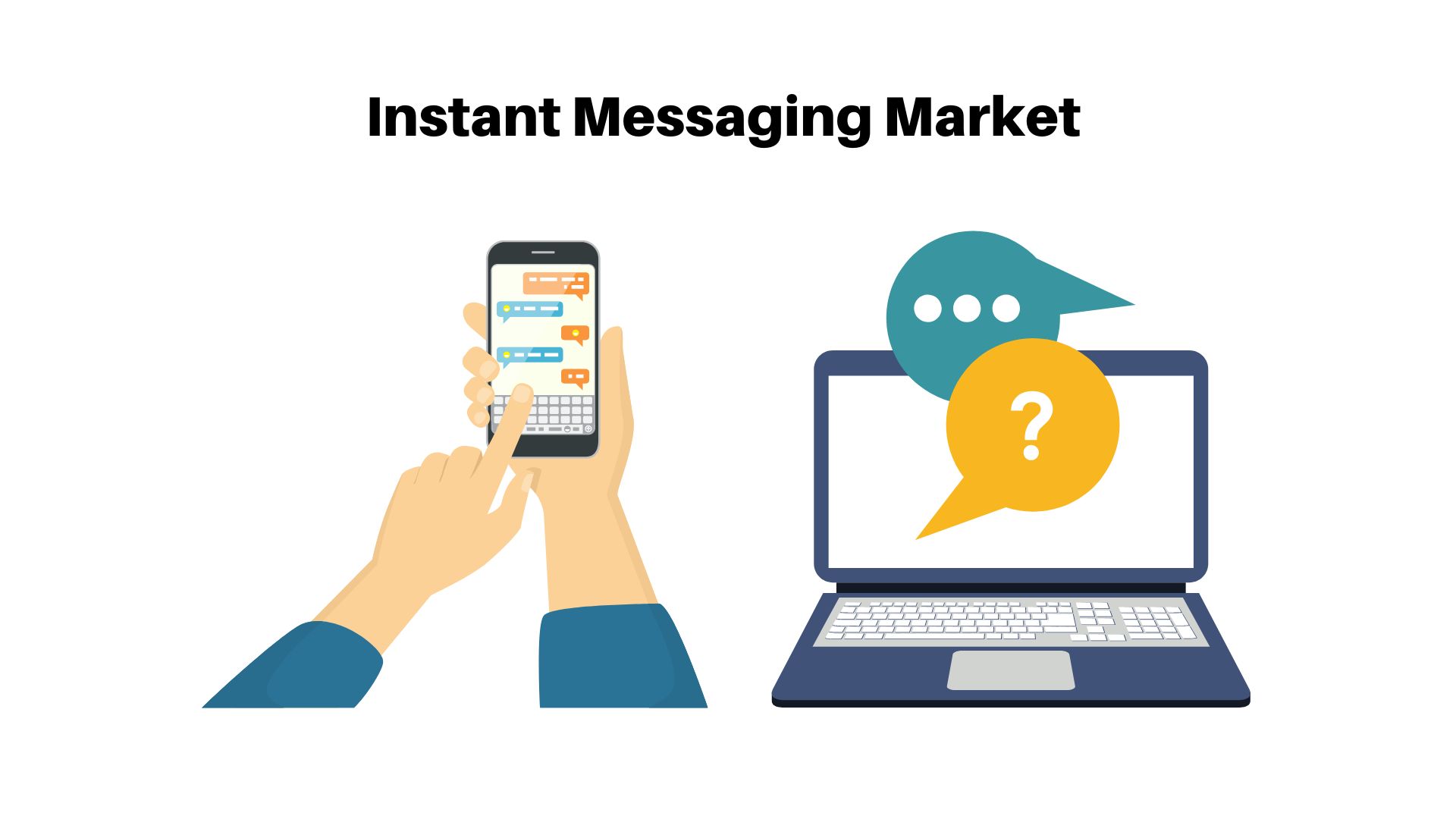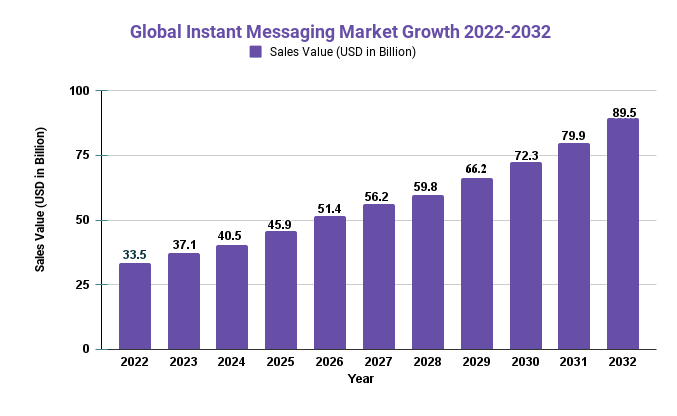Instant Messaging Market raise at a CAGR of 10.6% & Surpass USD 89.5 Bn by 2032

Page Contents
Market Overview
Published Via 11Press: The Instant Messaging Market size is expected to be worth around USD 89.5 Bn by 2032 from USD 33.5 Bn in 2022, growing at a CAGR of 10.6% during the forecast period from 2022 to 2032.
In recent years, the Instant Messaging market has experienced remarkable growth. With the proliferation of smartphones and other mobile devices, instant messaging platforms have become a ubiquitous form of communication for millions around the world. This trend is expected to continue as more people seek real-time, convenient ways to stay connected with friends, family members, and colleagues.
One of the primary factors driving growth in the Instant Messaging market is an increasing need for secure and private messaging services. As consumers become more aware of privacy risks online, they are turning to instant messaging apps with end-to-end encryption and other security measures. These apps give users more control over their personal data while helping them avoid unwanted surveillance or monitoring by third parties. Another factor fueling the growth of the Instant Messaging market is the rise of remote work and virtual collaboration tools.
Request For Sample Report Here: https://market.us/report/instant-messaging-market/request-sample/

Key Takeaways
- The dominance of WhatsApp and Facebook Messenger, WhatsApp, and Facebook Messenger are the two most widely used instant messaging apps globally, with over 2 billion and 1.3 billion active users respectively.
- Rise of Chinese Apps, Chinese messaging apps like WeChat, QQ, and LINE have become increasingly popular, particularly in the Asia-Pacific region. WeChat, for example, has over 1 billion active users.
- Increasing Use for Business, Instant messaging apps are increasingly being used by businesses for internal communication and customer support. Apps like Slack and Microsoft Teams are specifically designed for business use.
- Integration with Other Services, Many instant messaging apps have integrated additional features, such as payment systems, news feeds, and gaming platforms, in an attempt to keep users engaged.
- Emphasis on Security and Privacy, In the wake of data breaches and privacy concerns, many messaging apps have emphasized their commitment to security and privacy, with end-to-end encryption becoming a standard feature.
- Expansion into Emerging Markets, As smartphone adoption grows in emerging markets, instant messaging apps are expanding their reach by offering lite versions of their apps that consume fewer data and work on low-end devices.
- With the growing importance of AI, Instant messaging apps are increasingly using artificial intelligence to improve user experience and offer additional services, such as chatbots for customer support and voice assistants for messaging.
Overall, the instant messaging market is expected to continue growing as more people adopt smartphones and internet connectivity becomes more widespread.
Regional Analysis
- North America WhatsApp and Facebook Messenger are popular in North America, but other apps like iMessage, Telegram, and Signal also have significant user bases. Instant messaging is commonly used for both personal and business communication.
- Europe WhatsApp and Facebook Messenger are dominant in Europe, with high adoption rates in many countries. Telegram is also popular, particularly in Eastern Europe. Many messaging apps in Europe prioritize security and privacy features.
- The Asia-Pacific region has a diverse messaging market, with different countries favoring different apps. WeChat is dominant in China, LINE is popular in Japan and Southeast Asia, and WhatsApp has a growing user base in India. Many messaging apps in the region offer additional features like payment systems and social networking.
- Latin America WhatsApp is the most popular messaging app in Latin America, with over 80% of internet users in the region using the app. Other apps like Facebook Messenger and Telegram also have significant user bases.
- Middle East and Africa WhatsApp is popular in the Middle East and Africa, with over 90% of internet users in some countries using the app. Other messaging apps like Telegram and Viber also have significant user bases. Instant messaging is commonly used for both personal and business communication in the region.
- Overall, the instant messaging market is shaped by regional preferences and cultural norms. Messaging apps that prioritize privacy and security are becoming increasingly popular globally, while apps that offer additional features beyond messaging, such as payment systems and social networking, are popular in some regions.
Drivers
Increasing Smartphone Penetration, The increasing adoption of smartphones around the world has provided a major boost to the instant messaging market, making it easier for people to communicate with each other anytime, anywhere. Convenience and Cost Savings Instant messaging is a more convenient and cost-effective way to communicate compared to traditional methods like SMS or phone calls, particularly for international communication. Integration with Other Services Instant messaging apps have integrated additional features like payment systems, news feeds, and gaming platforms, making them more engaging and useful for users.
Business Communication The use of instant messaging for business communication has become more popular, with many companies using messaging apps like Slack and Microsoft Teams to facilitate internal communication and collaboration. Increasing Importance of Privacy and Security, The increasing importance of privacy and security in the digital world has led many people to prefer messaging apps that offer end-to-end encryption and other security features. Expansion into Emerging Markets, Instant messaging apps have expanded their reach by offering lite versions of their apps that consume less data and work on low-end devices, making them more accessible in emerging markets. AI and Chatbots, The use of artificial intelligence (AI) and chatbots in messaging apps has improved user experience and made it possible to offer additional services like customer support and voice assistants.
Overall, the instant messaging market is driven by the need for more convenient and cost-effective communication, as well as the integration of additional features and improvements in security and privacy. As technology continues to evolve, the instant messaging market is expected to continue growing and adapting to meet changing user needs.
Restraints
Competition and Market Saturation The instant messaging market is highly competitive and saturated, with many popular apps competing for users' attention. This makes it challenging for new entrants to gain a share of the pie. Regulatory and Legal Matters, Instant messaging apps may face regulatory and legal problems related to privacy, data protection, and content moderation, particularly in countries with stringent regulations. Dependence on Internet Connectivity, Instant messaging apps rely on internet connectivity, which may be limited or intermittent in certain regions, especially emerging markets.
Security Concerns Despite improvements to messaging apps' security measures, there remains unease about the safety and privacy of user data in light of recent breaches and hacking incidents. Lack of Monetization Many messaging apps are free to use, relying on advertising or other methods for revenue. Unfortunately, this can present a challenge for smaller apps or those without an established user base. Fragmentation of User Base The popularity of different messaging apps varies by region and demographic, creating a fragmented user base that makes it challenging for businesses and marketers to connect with.
Overall, the instant messaging market faces several obstacles that could potentially limit its future growth and profitability. To address these problems, messaging apps may need to focus on improving security and privacy measures, expanding into new markets, and finding profitable ways to monetize their platforms.
Ask or share your questions, if any, before purchasing this report: https://market.us/report/instant-messaging-market/#inquiry
Opportunities
Expansion into Emerging Markets The instant messaging market has the potential to expand into emerging markets, where there is a rising demand for convenient and affordable communication. Messaging apps can offer lite versions of their applications that consume less data and work on low-end devices, making them more accessible in these locations. Integration with Other Services Instant messaging apps have the option to incorporate additional services like payment systems, news feeds, and gaming platforms, making them more engaging and useful for users.
Business Communication Businesses are increasingly turning to instant messaging for business communication, with many companies using apps like Slack or Microsoft Teams for internal communication and collaboration. There is now room for messaging apps to expand their services and provide more robust solutions for businesses. Improved Security and Privacy, Messaging apps have the opportunity to continue strengthening their security and privacy features, providing assurances about user data safety and protection.
AI and Chatbots, The integration of artificial intelligence (AI) and chatbots into messaging apps has enhanced user experience and allowed for additional services like customer support or voice assistants. As messaging apps continue exploring how best to utilize AI and bots together, there will be ample opportunities to provide innovative new offerings. Monetization. Messaging apps have the opportunity to explore new monetization methods, such as selling virtual goods, premium subscriptions, or advertising.
Overall, the instant messaging market offers several prospects for growth and innovation, particularly in emerging markets, business communication, and the integration of additional services. Messaging apps that address user security and privacy concerns while finding new ways to monetize their platforms are well-positioned for future success.
Challenges
Monetization, The instant messaging market is dominated by free apps that rely on advertising or other means to generate revenue. However, monetizing messaging apps can be a challenge, particularly for smaller apps or those that do not have a large user base. Competition and Market Saturation The instant messaging market is highly competitive and saturated, with many popular apps vying for users' attention. This can make it difficult for new entrants to gain market share.
Security Concerns While messaging apps have improved their security features, there are still concerns about the safety and privacy of user data, particularly in the wake of data breaches and hacking incidents. Regulatory and Legal Issues, Instant messaging apps may face regulatory and legal issues related to privacy, data protection, and content moderation, particularly in countries with strict regulations. Fragmentation of User Base, The popularity of different messaging apps varies by region and demographic, leading to a fragmented user base that can be difficult for businesses and marketers to reach. Adapting to Changing User Needs, Messaging apps need to constantly adapt to changing user needs and preferences, as well as evolving technology and market trends, to stay relevant and competitive.
Overall, the instant messaging market faces several challenges that could impact its future growth and profitability. Messaging apps that focus on addressing user concerns about security and privacy, finding new ways to monetize their platforms, and adapting to changing user needs are likely to be better positioned for future success.
Report Scope
| Report Attribute | Details |
| The market size value in 2022 | USD 33.5 Bn |
| Revenue forecast by 2032 | USD 89.5 Bn |
| Growth Rate | CAGR Of 10.6% |
| Regions Covered | North America, Europe, Asia Pacific, Latin America, and Middle East & Africa, and the Rest of the World |
| Historical Years | 2017-2022 |
| Base Year | 2022 |
| Estimated Year | 2023 |
| Short-Term Projection Year | 2028 |
| Long-Term Projected Year | 2032 |
Key Market Segments
Type
- Enterprise Instant Messaging
- Consumer Instant Messaging
Application
- Business and Enterprise Chatting
- Personal Chatting
- Entertaiment and Social Chatting
Key Market Players
- BigAnt
- Cisco Jabber
- HipChat
- IBM Lotus Sametime
- Kakao Talk
- Line
Frequently Asked Questions
What is the market study period?
The Instant Messaging Market is studied from 2017 – 2032.
What is the growth rate for the Instant Messaging Market?
The Instant Messaging Market is growing at a CAGR of 10.6%
Which region experiences the highest rate of growth in the Instant Messaging Market?
Asia Pacific is growing at the highest CAGR over 2022- 2032.
Which region is the largest in the Instant Messaging Market?
North America holds the highest share in 2022.
Who are the major players in the Instant Messaging Market?
BigAnt, Cisco Jabber, HipChat, IBM Lotus Sametime, Kakao Talk, Line, WeChat, WhatsApp
The team behind market.us, marketresearch.biz, market.biz and more. Our purpose is to keep our customers ahead of the game with regard to the markets. They may fluctuate up or down, but we will help you to stay ahead of the curve in these market fluctuations. Our consistent growth and ability to deliver in-depth analyses and market insight has engaged genuine market players. They have faith in us to offer the data and information they require to make balanced and decisive marketing decisions.


